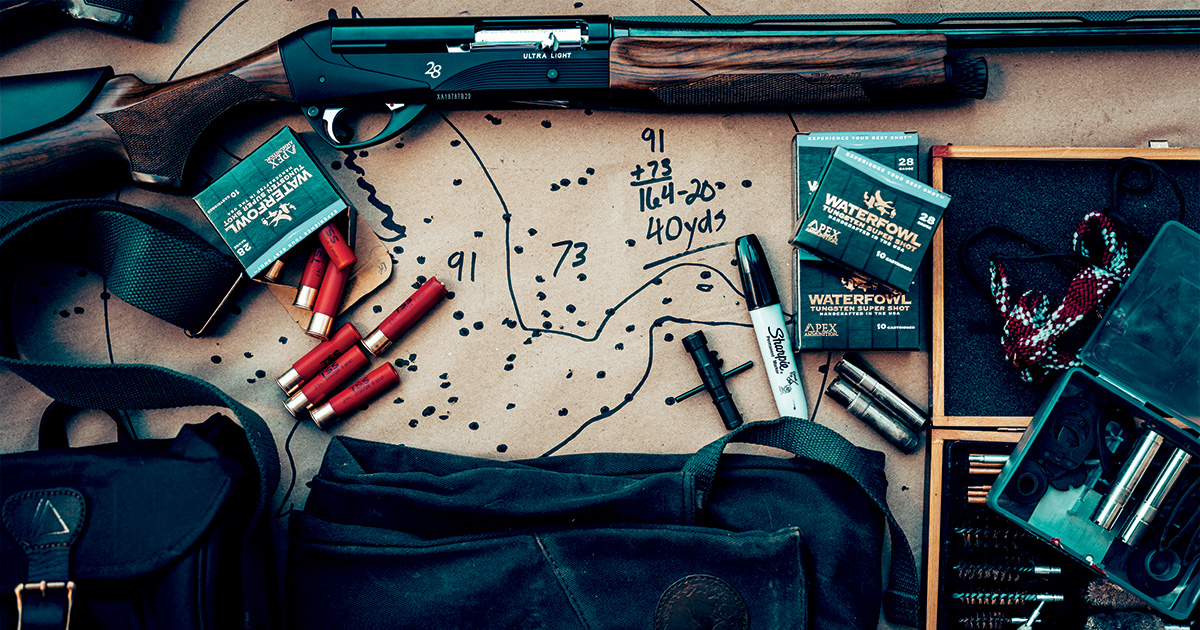Shotgunning: Going Light
New nontoxic loads have made 20- and 28-gauge shotguns increasingly popular among waterfowlers
New nontoxic loads have made 20- and 28-gauge shotguns increasingly popular among waterfowlers

Premium ammo, such as these Apex 28-gauge TSS loads, have made small-bore shotguns a viable option in many waterfowl hunting situations.
Until recently, the 20-gauge was thought of as a gun for young, new, or small waterfowlers, or for the recoil-shy. The 28-gauge was an upland gun, period. It’s a different story today, and there is a lot for waterfowlers to like about these small-bore guns. They’re light, trim, and easy to handle. They weigh virtually nothing on your shoulder as you hike to the blind or wade in the woods, and they don’t pound you with recoil. Used within their limitations and with the right ammunition, they can be effective on ducks and even geese. If you’re thinking of downsizing, here are some factors to consider.
Small-bores have been hyped as the new do-it-all shotguns before. The introduction of the 3-inch 20-gauge in the mid-1950s sparked a brief flurry of interest, but the 12-gauge was still the better duck gun, and waterfowling remained largely a 12-gauge game. In fact, the end of the lead shot era sent hunters toward bigger, not smaller, guns, and 3 1/2-inch 12- and 10-gauges became popular because they could hold big payloads of large steel pellets.
The development of other types of nontoxic pellets, including bismuth, Hevi-Shot, and TSS, led to renewed interest in 20- and 28-gauge shotguns for waterfowling. Because pellets made from these materials are much denser than steel, you can fit more of them into a slender hull. A 3-inch 20-gauge becomes a more-than-adequate gun for ducks and geese over decoys once it’s loaded with an ounce to 1 1/8 ounces of bismuth 3 shot or an ounce of Hevi-XII 4s. While a 20-gauge can’t generate the same velocities that a 12-gauge can, speed doesn’t matter as much with these premium pellets as it does with steel, because the denser pellets retain velocity so well.
The new 3-inch 28-gauge shells loaded by Hevi-Shot, Boss, Federal, and others make the 28 a viable waterfowl gun. A 3-inch 28-gauge Boss bismuth load, for instance, holds 1 1/16 ounces of shot in various sizes, while Hevi-Shot offers 3-inch 28-gauge loads containing a full ounce of 4 or 6 Hevi-XII shot. Federal has 3-inch 28-gauge steel loads for those who would rather not pay for the premium nontoxics.
Properly loaded, small-bore guns can handle most waterfowling situations. Teal, ducks over decoys, and ducks in the woods are all within range of a 20- or 28-gauge loaded with steel ammo. Bismuth, Hevi-XII, or, if you can afford it, TSS not only extend your range but make shooting geese over decoys a small-bore possibility. Remember, though, that anything a small-bore can do, a 12-gauge can do with more shot and more velocity, and the 12 has the capacity to hold large pellets like BBs and BBBs, which don’t stack well in skinnier hulls. Also, if you want to stick with steel to keep your ammo costs down, you should consider shooting a 12-gauge.
There are plenty of 20-gauge waterfowl guns on the market, and Benelli and Beretta now offer 3-inch 28-gauge semiautos, while Franchi has a 3-inch 28-gauge over/under.
As waterfowl guns, small-bores have their advantages. Lighter recoil helps you shoot better. You aren’t anticipating a painful kick, and you can get back on target for second and third shots faster. However, for all but the smallest-framed shooters, a heavier 12-gauge is an easier gun for most people to shoot well. A heavy gun actually points faster than a lighter gun, without bouncing around the way some featherlight small-bores do. A heavy gun is also easier to swing smoothly on longer crossing and overhead shots. And, you can downsize to 12-gauge 2 3/4-inch shells for lighter recoil while still exceeding small-bore performance.
Small-bore loads are not noticeably quieter than 12-gauges, nor are they more sporting. What they are is fun for many hunters, while also being totally capable of taking ducks and geese cleanly at reasonable distances with premium ammunition. When all goes well and birds are decoying, small-gauge guns are a delight to shoot and to hunt with. And that, for a lot of hunters, is reason enough to own one.
Ducks Unlimited uses cookies to enhance your browsing experience, optimize site functionality, analyze traffic, and deliver personalized advertising through third parties. By continuing to use this site, you agree to our use of cookies. View Privacy Policy